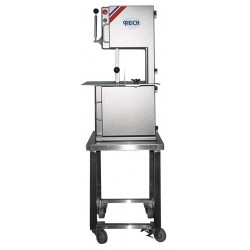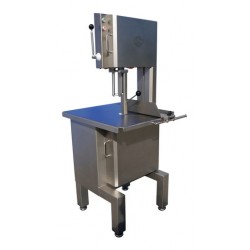Meat saws are food-industry equipment that let you cut meat and bone into portions on an industrial scale. These devices allow you to process meat carcasses, poultry, or fish – whether frozen, fresh, or chilled – quickly and at the highest quality.
They are used to:
- divide carcasses into half-carcasses;
- cut quarters and cuts;
- derive portions of various sizes from meat and meat-and-bone semi-finished products;
- cut bones, large blocks of meat, frozen chunks;
- divide up fish carcasses and semi-finished goods from fish;
- cut raw meat or fish inputs into portions of identical size;
- obtain a perfectly straight edge.
The type and model of meat saw depend on your specific tasks to be solved.
Synonyms: meat saw, meat cutting saw, band saw for meat, meat and bone saw, manual meat saw, electric meat saw, reciprocating saw, commercial meat saw, floor bone saws, tabletop meat saw, a circular saw for meat, electric band saw for meat, manual band saw, mini-saw for meat, suspended meat saw.
How saws for meat and bone are classified
Saws are categorized according to the following basic types:
- band saws,
- circular saws,
- reciprocating (push-and-pull),
- suspended saws.
These basic types are decisive in the food industry.
Band saws for meat and bone
These mainly serve to cut up carcasses (whether fresh, chilled, or frozen) as well as frozen patties and chunks. These units cut products up into portions in a very short time, and they quickly and easily cut up not only flesh alone but also meat still on the bones.
The major advantage of electric band saws is the precision by which they divide products up into portions with minimal wastage. The result is pieces that are perfectly equal, and very few small scraps left over.
Band saws for cutting up meat and bones are among the most common units in the food industry.
They are available in the following forms:
- floor models,
- tabletop models,
- suspended models
Suspended electric band-saw models are needed for conveniently cutting carcasses into half-carcasses. The saw is used suspended from above, and carcasses placed on hooks are cut in a hanging position.
With a suspended electric saw for meat, you can significantly save on space in your production facility.
Tabletop band-saw models are mini-saws for meat that do not require a lot of space to operate, which is a great thing, but they are only capable of processing very small volumes of product. They are an effective solution for obtaining pieces of equal size from raw inputs, and they also ensure maximally equal cuts. However, small butcher saws do not have enough power to cut up large carcasses.
Floor band saws are categorized according to the functions they carry out: cutting half-carcasses into quarters, cutting raw meat into equal portions, and much more. For saws of this design, the dimensions of the machine determine the height of the pieces that are sawn, while the width of the pieces depends on the specifications of the working surface. The counter of a floor band saw can be movable or fixed, which is also a functional option.
The floor version of the band saw offers a number of advantages, which makes these units the most popular ones in the food industry:
- they efficiently and effortlessly cut up both meat and large bones;
- they are easy to control;
- they are highly reliable and offer a long service life;
- they can work with fresh, chilled, or frozen products;
- they ensure maximally equal cuts on the finished pieces;
- there are no bone fragments or tiny pieces left over;
- they feature built-in special regulators that set the shape and size of the pieces;
- they have an ergonomic design and are easy to disassemble and clean;
- the bearing part is slip-resistant.
These units are electrically powered. The cut is made with a clamping mechanism, the height of which is adjustable. To ensure safe and convenient operation, the blades can be fixed.
The characteristics of the saw’s blade determine how a band saw performs when cutting meat and bone.
For small-scale production, a medium-sized saw with a working surface of 33x33 cm will suffice. For larger batches or when working with large volumes, a cutting blade of 40x40 cm or larger is required.
In addition to the dimensions and the length of the blade, the dimensions of the teeth are also important. Blades with fine teeth will ensure a clean and neat cut for your products.
Circular saws for meat
These are used for cutting meat and bones on small carcasses of animals, poultry, and fish.
Circular saws are distinguished by their reliability and their ease of use and servicing. Their mobility, compactness, and convenience of operation set them apart.
Circular saws differ in the power of their motors. The blade of these saws is a disc with pointed edges. They can effortlessly cut up a carcass that has been laid on a horizontal surface or hung from above.
Circular-saw units differ in:
- the size of the cutting discs (different depths of cuts);
- the material from which they are manufactured (light steel with polycarbonate or high-quality steel).
The target for the saw, i.e. the kind of meat that your main product represents, is what determines the shape and diameter of the disc that you need. The refinished cutting edges are carbide-tipped for extended service life. The teeth require regular sharpening along the entire cut line. The type of meat that is to be processed also affects how the blade is to be sharpened.
According to how they are operated, units are categorized as stationary (floor models) or manual. Stationary models are ideal for working with small carcasses (fish, birds, rabbits). Manual circular saws are commonly used for cutting whole carcasses into separate pieces.
The main drawback of circular saws is the width of the cut: circular-saw cuts are wider than band saws. In practice, this means a larger amount of wastage compared to the total amount of product.
Reciprocating saws for meat
Reciprocating saws (also known as oscillating saws) are famous in the food industry for their multi-functionality. They are used for dividing half-carcasses into quarters and for cutting flesh and bone up.
What sets this group of saws apart is how pronounced and deep the cut is. There are no limits to how deep the cut can be.
These saws divide carcasses by means of a single flat cutting element with serrated edges. The saws work through a push-and-pull motion.
These machines are very high-performance. They not only offer proven reliability and durability, but they are also economical to operate. Even at high speeds, consistent quality of the cut is ensured.
These models of saws are light and extremely maneuverable – manual models can be used without a balancer.
Manual saws for meat
Besides electrically powered equipment, there are also manually operated mechanical saws for cutting meat. In their appearance, these tools resemble a large hacksaw or reciprocating saw.
Handsaws for cutting meat and bones are suitable for both chilled and frozen meat.
In the food industry, handsaws are not widely used. Due to their low throughput, these devices are used mainly in ad hoc cases.
In terms of how they are installed, industrial saws for cutting meat are categorized as:
1. Floor saws.
Large-size equipment that allows you to cut bulky products while minimizing wastage.
2. Tabletop saws.
Compact models that offer functionality similar to floor units and are used for relatively small inputs.
3. Suspended saws.
For greater convenience, heavy manual units are equipped with special suspension (a balancer).
|
Types |
Band saws |
Circular saws |
Reciprocating saws |
|
floor |
+ |
- |
- |
|
tabletop |
+ |
+ |
+ |
|
suspended (with manual control) |
+ |
+ |
+ |
The complete set of some electrical units for sawing meat and bones, for example, band saws and circular saws, includes such elements as:
- a metal frame (a body manufactured from stainless steel or aluminum alloy);
- an electric motor of open type or inside the body;
- the working area (tabletop)
- the saw blade (cutting blade);
- a limiter to regulate the size of the finished pieces;
- a special lifter that feeds the carcass into the processing area and ensures the safety of the machine’s operation
- a frame for mounting the equipment.
The raw inputs move over the working surface by means of a lifter. Through the movement of the cutting blade, the product is precisely cut into identical pieces of a given size; large pieces are made smaller. The processed products are then directed into a separate compartment, while waste is sent into a special container. Specially designed covers shield the equipment’s moving parts. Each device is equipped with protection against accidental activation.
All types of food equipment, regardless of their design, conform to strict requirements in terms of the materials from which they are manufactured. The body of the unit and the saw parts that cut up the meat are manufactured from food-grade metals. To ensure safe interaction with food, the blade of the saw is manufactured from stainless steel or cast aluminum, so there is no risk of corrosion.

 English
English
 Deutsch
Deutsch
 Français
Français
 Español
Español
 Italiano
Italiano
 Português PT
Português PT











